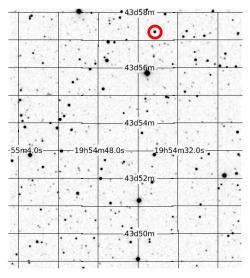 | ||
Similar Kepler‑186f, Kepler‑452, Kepler‑22, Kepler‑42, Kepler‑69 | ||
Kepler 186
Kepler-186 is a main-sequence M1-type dwarf star, located 151 ± 18 parsecs (492 ± 59 light years) away in the constellation of Cygnus. The star is slightly cooler than the sun, with roughly half its metallicity. It is known to have five planets, including the first Earth-sized world discovered in the habitable zone: Kepler-186f. The star hosts four other planets discovered so far, though Kepler-186 b, c, and d are too close, but e is near the habitable zone's inner edge.
Contents
- Kepler 186
- Star
- Discovery of a planetary system
- Planetary system
- Kepler project
- Outside the Kepler project
- References
Kepler 186
Star
A number of previously unknown measurements of the star are known. In the infrared/microwave EM spectrum its H band magnitude is 11.605, J band magnitude is 12.473, and its K band magnitude is 11.605. In the visual Photometric system magnitude it is 14.90(R)(towards the red end of the visual spectrum) and 16.40(B)(the blue end of the spectrum) (see also Apparent magnitude.) It is a BY Draconis variable changing brightness slightly, probably from starspots, with a period of 33.695 days.
The star is Red dwarf/M-class bordering on being an Orange dwarf/K-class star, with a mass nearly half that of the Sun's, with a density ~1.59 x 105 kg/m3.
Discovery of a planetary system
Within two first years of gathered data, the signals of four inner planetary candidates were found. Discussion of planets in the system was taking place in August and November 2013. In February 2014, those planets were confirmed through the "verification by multiplicity" method. The fifth outermost candidate was confirmed in the same manner in April 2014. The possibility that the signals in the light curve of the star were actually from something else has been ruled out by an investigation with the W. M. Keck and Gemini Observatories, using speckle imaging and adaptive optics techniques, which, while unable to resolve the planets, were able to rule out other possibilities than the system of planets.
Planetary system
The five planets discovered around Kepler-186 are all expected to have a solid surface. The smallest one, Kepler-186b, is only 8% larger than Earth, while the largest one, Kepler-186d, is almost 40% larger.
The four innermost planets are probably tidally locked, but Kepler-186f is further out, where the star's tidal effects are much weaker, so there may not have been enough time for its spin to slow down that much. Because of the very slow evolution of red dwarf stars, the age of the Kepler-186 system is poorly constrained, although it is likely to be greater than a few billion years. There is a roughly 50-50 chance it is tidally locked. Since it is closer to its star than Earth is to the Sun, it will probably rotate much more slowly than Earth; its day could be weeks or months long (see Tidal effects on rotation rate, axial tilt and orbit).
Planetary formation simulations have also shown that there could be one additional non-transiting low-mass planet between Kepler-186e and Kepler-186f. If this planet exists, it is likely not much more massive than Earth. If it were, its gravitational influence would likely prevent Kepler-186f from transiting. Conjectures involving the Titius–Bode law, (and the related Dermott's law) indicate that there could be several remaining planets to be found in the system - two small ones between e and f and another larger one outside of f.
Low metallicity of the star, at -.26 relative to the Sun or put another way about half that of the Sun, is associated with a decreased chance of planets overall and giant planets specifically but an increased chance of Earth sized planets in a general study of stars.
Kepler project
As the Kepler telescope observational campaign progressed initial identifications of systems were entered in the Kepler Input Catalog(KIC), and then progressed as a candidate host of planets as Kepler Object of Interest(KOI). Thus Kepler 186 started as KIC 8120608 and then was identified as KOI 571.
Outside the Kepler project
Outside of the Kepler project, the 2MASS survey catalogued this star as 2MASS J19543665+4357180.
